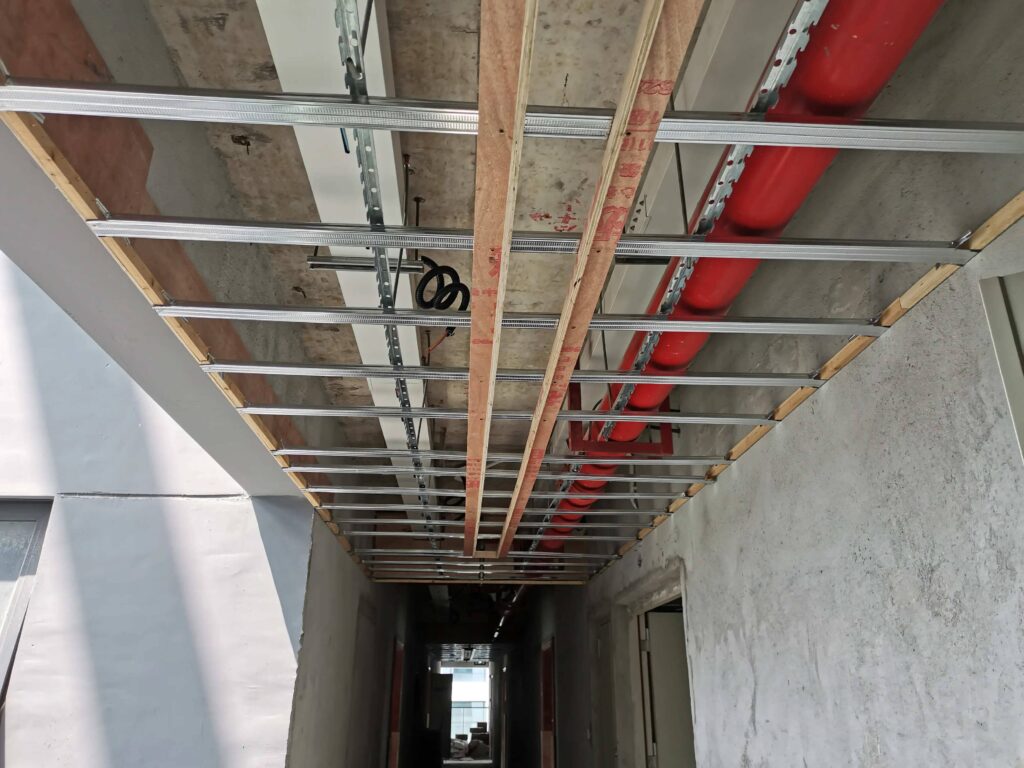
Interior work: Structure, surfaces, covering, painting, waterproofing, plumbing/electrical work.
Our focus today will be on the ceiling industry. Given the amalgamation of finishes and installations, a brief introduction is provided. Subsequently, a comprehensive review of the types of installation is carried out. This crucial information needs your attention.
Ceiling Suspension: Suspended ceilings hide vital equipment such as fire suppression, surveillance, HVAC, and lighting.
Before installation, ceiling hanging hooks must be pre-embedded and attached to various plates.
Suspended ceilings primarily fulfill:
- Block moisture, contamination, and smoke propagation. Facilitate cleaning.
- Alter interior aesthetics, suitable for residential/dining/bedroom spaces.
- Conceal luminaires offer soft, naturally reflected illumination similar to sunlight.
- Safeguard pipe system enclosures.
- Adjust uneven ceilings by changing the ceiling frame.
Ceiling adornments are separated according to their primary material, including gypsum, mineral wool, plywood, aluminum, glass, and honeycomb ceilings.
These include gypsum board, aluminum board, PVC board, and mineral wool board.
Gypsum board is lightweight, robust, fire resistant, effectively insulates, and mitigates noise. It is suitable for various spaces such as living rooms, study rooms, bedrooms, etc.
An aluminum gusset plate offers resistance to corrosion, fire, moisture, and cleanliness. It is ideal for humid areas such as kitchens and bathrooms.
PVC board is waterproof, moisture-resistant, flame-retardant, and easy to maintain. It is suitable for kitchens, bathrooms, and other damp areas.
Mineral wool board is ideal for meeting rooms, theatres, concert halls, and other locations requiring sound insulation, thermal insulation, fireproofing, and moistureproofing.
What art styles complement suspended ceilings? Art diversifies its aesthetic expression. Classical ceilings replicate a majestic, lasting ambiance similar to extensive historical artworks. Contemporary ceilings mirror current trends, employing minimalist yet sophisticated designs. Moreover, American design conveys a strong personality with its unique appeal. Mediterranean ceilings infuse homes with vibrancy through their vibrant, organically inspired settings. Each artistic style has a distinct charm, offering endless options for residential areas.
The optimal ceiling material depends on your circumstances and preferences, including style, budget, and building stability. Contemporary aesthetics often use metal, glass, or varnished paint for a modern atmosphere. For budget constraints, gypsum board and wood offer cost-effective alternatives with minimal charm. Maintaining the structure of the property is vital when choosing ceiling materials. Adequate floor height allows a concave or flat ceiling configuration. However, in limited spaces, practicality prevails. Durability and warping, among other factors, should be considered in this selection process.
Ensuring punctuality and full support throughout corrugated ceiling projects is critical. Prioritize understanding load-bearing requirements during material selection to manage excess ceiling components. To ensure accuracy, ensure that the ceiling hook, steel profile, and plywood align with the design’s dimensions and specifications. For stable suspended ceilings, construct the steel frame and install the hook. Upon completion, verify standards such as flatness and height through measurement and inspection. At the same time, prioritize fire prevention and moisture protection for ceiling longevity.
Ceilings and pipes coexist harmoniously within a given space without causing any conflict. Exposed pipes can be attractive in kitchens and bathrooms with multiple water sources. Alternatively, concealing them using suitable pipes maintains functionality while enhancing interior aesthetics. Thus, a well-chosen combination can enhance the overall interior design.

